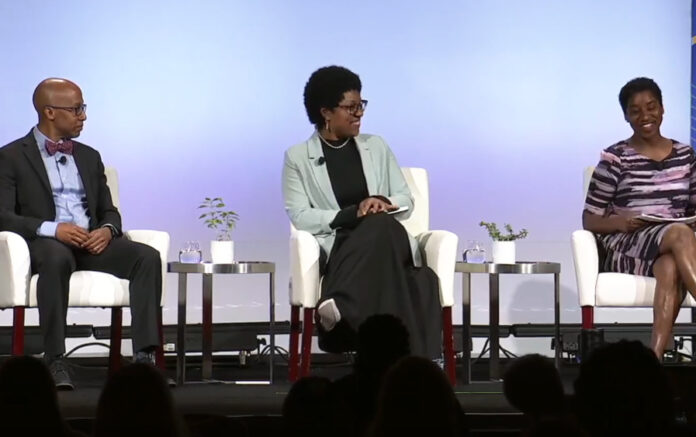A powerful panel led by Faith Nyong, RN, Dr Qadira Ali, and Dr David Bowman this morning challenged practitioners to rethink lifestyle medicine through the lens of health equity. Their message was clear: lifestyle interventions cannot be divorced from the social realities that shape health outcomes.
For Whole Food Living readers, this conversation resonates deeply with our mission to amplify evidence-based wellness while acknowledging the lived experiences of diverse communities.
One of the most striking points raised was the distinction between equity and equality. Equality suggests that everyone receives the same resources. Equity, however, demands that resources meet unique individual needs.
In practice, this means tailoring lifestyle medicine interventions to patients’ cultural, economic, and geographic contexts. A plant-based nutrition plan may be ideal in theory, but if fresh produce is unaffordable or unavailable, it remains inaccessible. As the presenters emphasised, “quality healthcare” must align with patients’ values, needs, and preferences—not just clinical guidelines.
The panel critiqued the current healthcare system’s tendency to prioritise pharmaceuticals over lifestyle interventions. Evidence shows that regular medical check‑ups alone do not reduce overall mortality or major chronic disease outcomes. Yet lifestyle behaviour modification—nutrition, physical activity, stress management, sleep, and social support—offers profound opportunities to improve outcomes, particularly in high‑risk populations. The challenge lies in shifting systemic priorities to recognise lifestyle medicine not as an adjunct, but as a cornerstone of care.
JR’s example
The slides shown included a compelling case study of “JR,” an eight-year-old boy presenting with obesity and elevated lipids. His social history revealed food insecurity, unsafe neighbourhood conditions, and limited access to sports due to financial barriers. The treatment approach was not a prescription pad, but community-based solutions: SNAP/WIC referrals, produce prescriptions, nutrition education, and free youth sports programs.
The results were transformative—JR’s weight and cholesterol improved, and his family began embracing healthier food choices. His mother’s testimony underscored the importance of access: “The grocery store in my neighbourhood has poor quality fruits and vegetables… Every bag I received through this program was very fresh.” This story illustrates how lifestyle medicine, when applied with cultural competence and community support, can overcome systemic barriers.
The presenters identified three essential ingredients for equity: access, culture, and trust. Addressing access gaps means recognising that not all patients can afford gym memberships or shop at farmers’ markets.
Culturally relevant interventions—such as dance programs at community centres or cooking classes tailored to local cuisines—make lifestyle medicine relatable. Trust, meanwhile, is advanced through respect and partnership. Patients must feel that their lived experiences are acknowledged, not dismissed.
Health disparities differ across groups: African American, Latinx, LGBTQ, and maternal/child health populations each face unique challenges. The intersection of poverty, geography, and policy compounds these barriers. Lifestyle medicine practitioners must tailor interventions for specific communities rather than assuming a one‑size‑fits‑all approach.
Bias awareness watch
This requires routinely asking about social determinants of health (housing, food, safety), building partnerships with community organisations, and committing to anti‑racism and bias awareness.
The slides highlighted how opportunities for physical activity differ across populations experiencing disparities. Unsafe neighbourhoods, lack of equipment, and financial constraints limit access. Solutions include low-cost home exercises, walking clubs through churches, and culturally resonant activities like dance.
Sleep equity was also emphasised, with factors such as noise pollution, light exposure, and housing conditions affecting rest. Addressing these requires both public health policy and practical tools—blackout curtains, white noise apps, and culturally competent screening.
Chronic stress disproportionately affects individuals with lower socioeconomic status and marginalised groups. The panel advocated for integrating social support into stress reduction programs. Community engagement—through faith groups, local organisations, and cultural centres—promotes resilience and reduces isolation. This aligns with positive psychology’s recognition of “eustress,” or beneficial stress, which can be harnessed when individuals feel supported and connected.
Faith Nyong shared a striking example from Kane County, Illinois, where partnerships between the health department, hospitals, and Black churches addressed disparities revealed by racial breakdowns of health data. Initiatives like the Gospel Walk and Food, Faith, and Fitness challenges produced remarkable outcomes, particularly among those with the greatest initial health burdens. These faith-based collaborations demonstrate the power of meeting communities where they are.
Practical, affordable & relevant
With cuts to SNAP threatening food security, partnerships with food pantries, farmers’ markets, and churches become vital. Community gardens, cooking workshops, and produce delivery programs empower families to adopt healthier diets. Even dollar stores can be leveraged, with beans, rice, frozen vegetables, and nuts offering affordable alternatives to chips and soda. The message is clear: lifestyle medicine must be practical, affordable, and culturally relevant.
The panel concluded by linking health equity to the Quintuple Aim: improving population health, enhancing patient experience, reducing costs, supporting provider well‑being, and advancing equity.
Equity is not an add-on—it undergirds the entire framework of an optimised healthcare system. For lifestyle medicine practitioners, this means embedding equity into every prescription, every counselling session, and every community partnership.
This session underscored that lifestyle medicine is not merely about individual choices—it’s about empowering communities to thrive despite systemic barriers. Health equity demands that practitioners listen, learn, and lead with cultural competence and respect.
For Whole Food Living readers, the takeaway is profound: wellness is not just a personal journey, but a collective responsibility. By aligning lifestyle medicine with equity, we can move closer to a world where every person has a fair chance at health.





